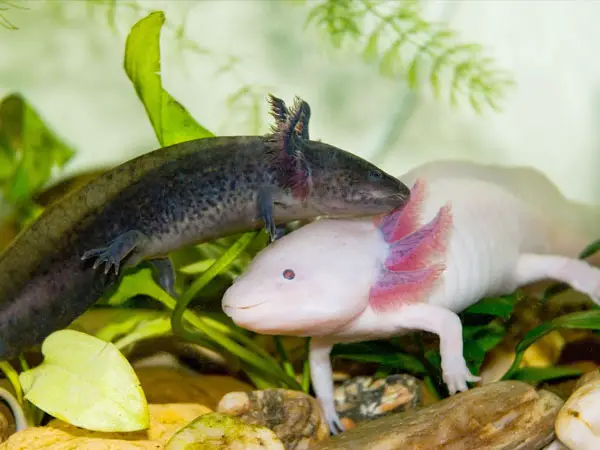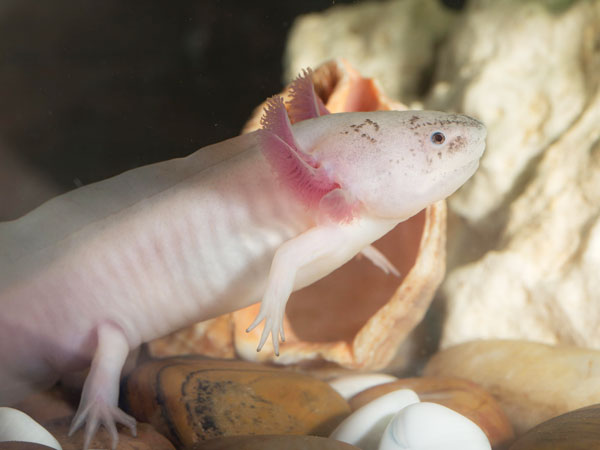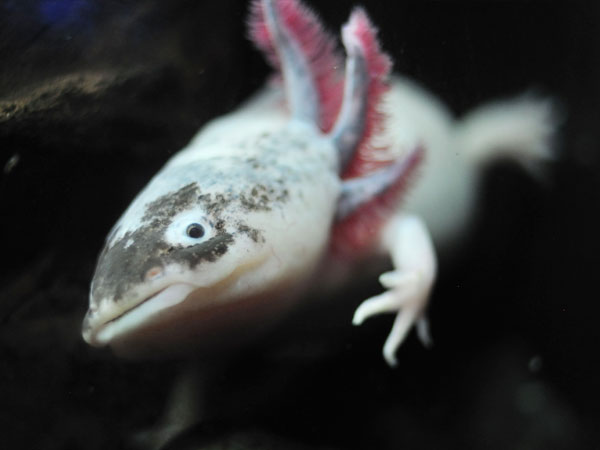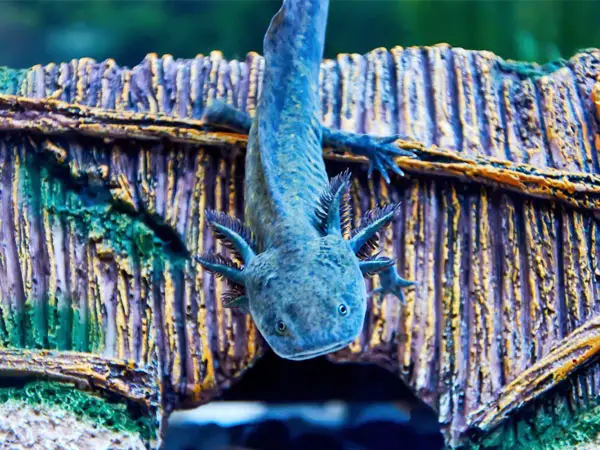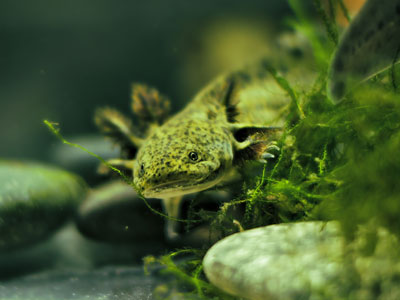
Axolotls can live in home aquaria; however, they have specific water requirements that must be met for them to stay healthy. If you fail to meet these requirements, you might put the health of your axolotl to risk.
In this article, I’m going to examine the water requirements of axolotls in terms of water pH, water hardness, water temperature, and other related requirements to help you create the best environment for your axolotl.
In doing so, I’m also going to explain the reasons why it’s important for water conditions to be at certain parameters and how you can offer your axolotls the best care.
Axolotl Water pH Requirements
Getting the water pH to optimal levels in your axolotl tank is crucial for the wellbeing of your amphibian pets. Water pH measures the alkalinity or acidity level of your water.
Axolotls will tolerate water with a pH in the 6.5 to 8.0 range, however, the ideal pH level for them is around 7.4 – 7.6.
Having a water pH outside the tolerated range can lead to ammonia toxicity, which can be fatal for your axolotl.
Why is pH Important?
The pH level of your water can affect the toxicity of ammonia, which is a potential deadly toxin, especially if it reaches high concentrations and it’s left unchecked.
Water with a pH value of 7 is considered neutral. Below 7 it’s acidic, while above 7 it’s basic. Going back to the ideal pH values for axolotls, around 7.4 – 7.6., we can conclude that axolotls prefer water that is slightly basic.
To limit the toxicity of ammonia, it’s important to keep the water in the tank within the pH range that’s ideal for axolotls. It’s also important to make sure that the pH values are stable.
How to Measure pH?
The only way to keep pH level stable in the aquarium is through regular testing. The easiest way to achieve this is through aquarium testing kits that will test for various parameters including pH and toxins.
Periodic testing will make sure that you can closely monitor water parameters and make the necessary adjustments as needed.
How to Adjust Water pH?
So, you’ve been testing your water and you notice that the pH level is closely approaching a value that’s outside the range admissible for axolotls.
When this happens, you have the option to adjust the pH level up or down, depending on the reading on the testing strip.
There are two different additives that you can use – pH Up and pH Down – that will lower or increase the pH level, depending on your situation.
Let’s assume that one of your pH tests returns a 6.6 value. You may want to adjust the pH level and bring it up to 7.3 – 7.4. To do so, you’ll need to use pH Up.
However, it’s important to adjust the pH slowly and avoid sudden changes, since those too can have a detrimental effect on your axolotls.
You’ll need to make incremental changes and raise the pH levels slowly, without stressing out your axolotls. Keep making adjustments and testing the water pH until you reach the desired value.
Axolotl Water Temperature Requirements
Water temperature is another important water parameter that aquarists must keep within the accepted range. Axolotls are sensitive to temperature variations; therefore, you must ensure stable water temperature.
The water temperature tolerated by axolotls is between 59 – 73 Fahrenheit (15 and 23 degrees Celsius). The ideal water temperature is between 60 – 64 Fahrenheit (16 and 18 degrees Celsius).
Variations in water temperature and water that is outside the permitted range for axolotls can have many unfavorable consequences including a propensity for diseases like fungal infections, loss of appetite, decreased mobility, and a host of other issues that could result in their death.
Which is Worst for Axolotls – Warm Water or Cold Water?
Warmer water than their acceptable range is especially bad for axolotls, which do best in colder water, but not too cold either.
Warm water can increase their metabolism, leading to a higher food consumption, and a higher waste production, which raises the concentration of ammonia in the tank. Warm water also has a lower concentration of oxygen.
All these can cause bacteria to multiply and fungi to get out of hand, leading to infections and diseases, some of which can potentially end up killing your axolotl.
By looking at the ideal temperature range for axolotls, you may have noticed that they do best in colder water. Of course, water that is too cold isn’t good either, but it’s nearly not as bad as warmer water.
Cold water slows down their metabolism, causing reduced mobility and a loss of appetite. While keeping your axolotl in cold water is not as bad as keeping them in warm water, you’ll still need to aim for that ideal range to make sure your axolotl remains healthy.
For most aquarists, cooling down the water for axolotls is a much bigger problem than making sure it’s warm enough.
How to Cool Axolotl Tank Water?
If you live in a region with very warm summers or warm weather all year around, keeping axolotls can be a challenge, especially when it comes to ensuring the right water temperature for them.
Here are some tips you can use to cool their water during a heat wave:
- Keep the tank in an air-conditioned room if you can, while monitoring the water temperature to make sure it doesn’t get too cold either;
- In the absence of air conditioning, keep the axolotl tank in a cold room (the basement works fine if you have one) away from direct sunlight or from excess sunlight;
- Freeze water bottles and place them halfway into the tank to reduce water temperature; keep replacing the bottles once they thaw out all the while monitoring water temperature;
- Invest in a tank cooling system if temperatures in your region are constantly high and you can’t keep the water temperature in the tank at acceptable levels.
As you can see, water temperature can be a difficult thing to adjust, especially if you need to lower the water temperature as increasing it can be easily achieved with the help of a water heater.
Axolotl Water Hardness Requirements
Water hardness is another important water parameter in axolotl care. Hard water is water that is high in calcium and magnesium salts, while soft water is low in dissolved mineral salts.
Axolotls prefer water that is slightly hard, which means that they require a good concentration of dissolved salts in their water.
Usually, tap water in most areas is hard, and you may already have tap water that is hard enough to meet the requirements of your axolotl.
However, it’s important to remember that mineral salts are not the same as table salt and you shouldn’t add table salt to your axolotl aquarium when you want to adjust hardness levels.
Hard water has a beneficial effect on gill function and the production of slime coating as well as other health benefits that your axolotls can enjoy if their water is in the right water hardness range.
Managing Toxin Levels in Axolotl Aquariums
You may already know that axolotls produce a lot of waste, which requires a good maintenance regimen to ensure that toxin levels in your aquarium don’t get out of hand.
Which toxins are most dangerous to your axolotls? How can you manage these toxins? And how often should you clean your axolotl tank?
Here are the toxins you should keep an eye on in your aquarium:
Ammonia
One of the sources of ammonia in your aquarium water may be tap water itself. While tap water usually contains only chlorine, which can evaporate from water if water is left to aerate enough time, another disinfectant, chloramine, can also be added to water supplies.
Chloramine is a much stable water disinfectant and it’s basically chlorine that’s bonded with ammonia. Since chloramine does not evaporate, you must use water conditioners to get rid of it.
Whether your water contains chloramine or chlorine, it’s crucial that you treat your tap water to get rid of these substances before you can use that water in an axolotl aquarium.
Another source of ammonia in your tank is decomposing organic matter that can have various sources like uneaten food that’s left in the tank to decompose, plants, or excess waste production.
Ammonia is extremely dangerous for your axolotl. Even values of 1 ppm (parts per million) pose a serious health risk, therefore, you must test for ammonia regularly and must perform water changes to wash away excess waste.
Your water testing kit should include a test for ammonia as well. Monitoring ammonia levels and educating yourself on how to prevent and manage ammonia levels is the only way to avoid its potentially devastating effects.
How to Prevent Ammonia Spikes?
Since prevention is always the best course of action, here are a few important things you should do to prevent deadly ammonia spikes in your tank:
- Always carry out the nitrogen cycle to its completion before adding axolotls to your aquarium;
- Don’t overfeed your axolotl (overfeeding leads to excess waste);
- Reduce the number of axolotls in a single tank (one is best);
- Scoop out any uneaten food and fallen plants (don’t let them decompose in the tank);
- Perform regular water changes (approx. 20% weekly);
- Siphon the substrate regularly;
- Invest in a biological and chemical water filter to promote the growth of healthy bacterial colonies which can keep the water chemistry more stable.
With these methods, you can avoid ammonia reaching toxic levels in your tank.
Nitrite
Another toxin that is harmful for axolotls are nitrites. Besides ammonia, you should also regularly test for nitrites.
Nitrites are produced when bacteria (nitrifying bacteria) in your aquarium consume ammonia. So, technically, by removing or preventing ammonia in your aquarium, you’ll also prevent nitrites from wreaking havoc.
While nitrites are less harmful than ammonia, they’re still harmful, and you must remove and prevent nitrites as well.
Just like ammonia, nitrite levels in your tank should also be at 0 ppm. Nitrites can be prevented with the same methods you’d prevent ammonia in your tank.
Nitrate
The reason to perform a nitrogen cycle in your aquarium is to establish a healthy colony of bacteria that feed on toxins like ammonia and nitrites.
Healthy bacterial colonies convert ammonia to nitrite and nitrite to nitrate in the last stages of the nitrogen cycle.
While ammonia and nitrite levels should be at 0 ppm, low levels of nitrates (between 20 and 60 ppm) are acceptable since they’re relatively safe for your axolotls.
However, when nitrate levels get too high, they can cause algae blooms in the tank and can become toxic to your axolotls.
Therefore, I recommend you test for nitrates just as often as you would test for ammonia and nitrites to check if levels are within the acceptable range for axolotl.
Detecting some nitrates in your tank is fine as long as it’s within the acceptable range. Detecting no nitrates, on the other hand, means that there are no healthy bacteria in your tank that could convert toxins to nitrates, and it signals that something is wrong in your aquarium.
When it comes to toxins in axolotl aquariums, you must follow the tips I mentioned above about performing the nitrogen cycle, carrying out tank maintenance, ensuring biological filtration, and monitoring toxin levels.
Axolotl Water Tank Maintenance
To help you offer your axolotl the best care, I compiled a quick tank maintenance checklist that you can use to prevent toxin levels from reaching dangerous levels.
Don’t Skip the Nitrogen Cycle
Make sure that you cycle your aquarium before adding any axolotls to the tank. The nitrogen cycle will establish a colony of beneficial bacteria that feed on toxins.
It takes a couple of weeks for the cycle to complete, therefore, I encourage you to read up as much as you can on the nitrogen cycle and make sure you carry it out properly since it’s one of the first crucial steps in creating a healthy environment for your pet axolotl.
Add an Aquarium Filter
An aquarium filter that allows bacterial colonies to form and offers chemical filtration as well is another line of defense in protecting your axolotls from the harmful effects of toxins like ammonia and nitrites.
However, make sure the water current from the filter is low since axolotls become stressed out from water currents.
Consider using a spray bar to disperse some of the currents and avoid stressing out your axolotls.
In the absence of an aquarium filter, you’ll need to perform daily water changes, which can be difficult to follow through.
Avoid Overfeeding
Overfeeding is dangerous. On the one hand, it increases waste production and the amount of organic matter in your aquarium.
On the other hand, it can cause constipation and bowel obstruction in your axolotl, putting its life at risk.
It’s enough to feed adult axolotls every 2-3 days and only growing axolotls should be fed every day.
Perform Regular Water Changes
Good tank maintenance is essential to dilute toxins and replenish the water. You should always check that the water you’re adding to the tank meets the parameters required for axolotls (pH, water hardness, temperature, etc.).
If you’re using tap water for water changes, use a water conditioner to neutralize chlorine and disinfection by-products.
Weekly 20% water changes coupled with siphoning the substrate and removing any rotting plants and uneaten food will help you keep the water chemistry balanced.
Limit the Number of Axolotls in Your Aquarium
Axolotls aren’t social animals and they do great even if kept singly. The danger of keeping multiple axolotls in the same tank is that they tend to nip at each other causing injuries that could get infected.
Besides the potential for injury and infection, multiple axolotls mean a much higher bioload to look after.
Axolotls also don’t make good tank mates for fish. They either end up eating any fish small enough to fit their mouth or fish end up nipping at the branch-like gills of axolotls.
Always Monitor Water Parameters
By investing in a water testing kit and an aquarium thermometer, you can keep an eye on water parameters and make necessary adjustments whenever they’re required.
All water parameters can be adjusted, the key is to catch any variation from the normal in time, and to do this, you must regularly test the water.
Conclusion
Axolotls may not be very difficult to care for in terms of feeding and diet but getting their water requirements right can become a challenge if you’re not an experienced aquarist.
Once you know more about their ideal temperature range, water pH, water hardness and other factors, you can recreate those conditions in your home aquarium.
A major challenge is keeping these water parameters as stable as possible and prevent toxin levels from accumulating in the aquarium.
I hope the information I shared in this article will prove useful for you in offering your axolotl the best conditions and the best care for a long and healthy life.

